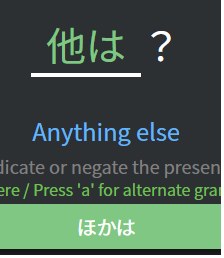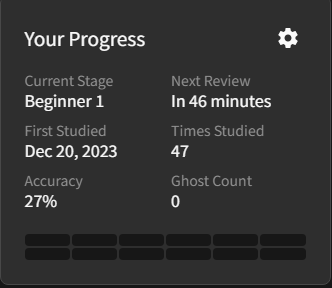We realize that the current form of this grammar point is “a bit” overwhelming.
It will be split, and improved in terms of explanations and answers.
Cheers 

We realize that the current form of this grammar point is “a bit” overwhelming.
It will be split, and improved in terms of explanations and answers.
Cheers 
Thank you so much!
It’s quite confusing, yes.
Any news on the update?
I’m very confused and I have no idea when to use 他にも vs. 他には…
What part do you not understand?
From the grammar point page / the OP
他に/にも/も/には/ all mean mostly the same thing. However, は has a stronger tendency to appear in negative sentences
他にも/他も doesn’t appear with negative sentences and この他 is used with nearby things.
ほかにも cannot be used in negative sentences with the exception of questions
I’d also recommend reviewing the meaning of は (contrastive) and も (also).
I’ve got to say the explanation of this grammar point is really poor.
You start by saying it is “regularly considered to be one of the more difficult structures to master in Japanese”, then go on to give an explanation that does not clear up the confusion in any way at all.
Unlike a lot of people here I don’t think the breakdown itself is too much of a problem, I tend to use the breakdown list as more of a reference than trying to memorise it off the bat. I just think the core explanation of this grammar point is horrible. You give multiple sentences that translate to the same in English but use different variations of 他, without explaining why each type is used. There’s just a general description “Another thing / even another thing / was there another thing” without any elaboration.
I literally feel like I’m having to memorise the answers to each sentence on this grammar point, since there is zero explanation given as to how the grammar works.
Glad I’m not alone on this, but disappointed that Bunpro don’t seem interested in addressing it after 2 years of complaints…
Positive feedback though, the example sentence annotations are useful
Until now I’m still confused. Maybe I just skip this grammar point all together.

Why isn’t this 他には? Most of the grammar points where you want は cut off the に which the grammar point say it needs. It appears to accept には for the answer but I don’t see anything saying what is the rule for 他には/他は
I guess its because this is a standalone question kinda like if you are asking if someone wants ramen.
ラーメンは?
or something like that.
In this case it is literally just: Other?
Another bump that this might benefit from a rework. After looking at the structure breakdown and starting to read the information section a few weeks ago I initially skipped it, but now it’s the only N4 point left for me, so… gotta do it, I guess. I don’t think I’ve found any other grammar point so far that felt this overwhelming, not even the conjugations (that sometimes had a ton of rules, but at least a clear focus).
Hi guys, and thanks for the feedback about this one! Since we added the proper writeup for this grammar point, we originally anticipated that there would be a lot less issues with it, due to the topic we cover in the caution section being the main point that most users seems to get mixed up with.
At the moment we are not planning on splitting this into two separate grammar points, as the part that appears to be the most confusing is the difference between は being used primarily in negatives, and も not being able to be used in negative sentences unless it is a question. We initially thought that seeing these both next to eachother (in the same way that we group the 誰かに 誰にも grammar structure) would actually be beneficial to the learning of this point and its variations.
After having read the guide/caution section for this grammar point, are there any areas that you feel we specifically don’t explain sufficiently well? I would love to make some small adjustments if there is anything we overlooked.
I’m back to level 0 after 4 months of SRS reviews.

Is there anyone to explain me like I’m 5?
Here are specific examples from my latest cram session I don’t understand:
Why can’t I use 他にも here? why can’t I use 他の here? same question, I’m using の to pair with the noun, what’s wrong here?Also why is it sometimes a warning, and sometimes directly an error?
What is the hint “inclusive” supposed to indicate on the prompt?
That concept is never addressed in the body of the grammar point, and in so far as I’ve found anyone using the terms in researching this grammar point, they use them in the opposite way. (that, は is exclusive, and も is inclusive)
他には(another “thing” separate from what was previously established)
他にも(another “thing” that is also part of what was previously established)
I know I’m pretty late on this feedback, but I also struggled here for a while but the bit that made it click for was the bit in the caution that says “他にも focuses on the addition of something” and then going back to the other sentences made them all make sense. I think this mention of it being focused on addition should also be in the main section when talking about 他に(も) and would help differentiate the different uses.
I think why it’s not as effective only being down there bc it’s easy to overlook, the focus of that caution section is on negative sentences and why you can’t use も in them, rather than when you do use も. So for me, I overlooked this super helpful bit a good number of times, and once I really attached that meaning of “in addition” to も, it all clicked.
Thanks for taking the time to read my feedback! <3
I really think that example should be reworked.
Currently it’s :
他に - Another thing.
他に(も) - Even another thing (sounds less certain).
他に(は) - Was there another thing (focuses on something pre-existing, which someone may have forgotten).
“Even another thing” would work just fine here since we just try to express “Do you want anything else”, right ?
この本だけですか。(この/この本の)他にもほしいものはありますか。
Only this book? Is there anything else (besides this one/this book) you want?
この大学に田中先生の他にも日本語の先生がいらっしゃいますか。
Are there any other Japanese teachers besides Tanaka-sensei at this college?
In the examples suggest the “beside what you have already”, which is also what a “Anything else” would mean, no ?
So can someone explain how to use 他には and how to use 他にも?
What’s also confusing to me is that the description talks about 他には then the very first example has no に, without any explanation!
This is doubly confusing, because は can be used to distinguish the topic, so it’s inherently “exclusive” (we are only talking about a hat, or today’s weather, or the test tomorrow) as opposed to も which I would say is “inclusive”.
Additionally, I don’t think the examples properly prepare you to make the leap to the first example question to which the answer is 他は. Yes, this is extremely simple and basic, but the lesson sets you up to expect to see the に particle in conjunction and its omission isn’t explained.
予定 here is indeed a noun.
It might be easy to overlook, but there are 2 different constructions with somewhat different meaning:
For more example sentences, the first one is also covered by 2 vocabulary items: 他 (JLPT N5) | Bunpro and 他 (JLPT N3) | Bunpro. For the second one there’s actually also a vocab entry 他に (JLPT N5) | Bunpro, so maybe there needs to be some de-duplication or at least cross-linking done here.
I think you can technically use ほかの of the first kind here, but the meaning will be different:
今日はスーパーに行く他の予定がない。
I don’t have other plans of going to a supermarket today.
(I’ve already been to a supermarket today/already plan to go today once, and I don’t have any plans to go a second time).
Here 行く would modify 予定, not 他.
スーパーに行く予定がない
スーパーに行く(他の)予定がない
But Bunpro is looking for “I don’t have any other plans at all, outside of going to the store”. So just 他 is not accepted and you have to use 他に of the second kind.
If you wanted to use 他の予定 in this sentence while preserving Bunpro’s requested meaning, you could, but you would need to somehow connect the first part to it. For example like this:
今日はスーパーに行く以外、他の予定がない。
Outside of going to the supermarket, I don’t have any other plans today.
今日はスーパーに行く他には、他の予定がない。(duplication makes this sound awkward)
Other than going to the supermarket, I don’t have any other plans today.